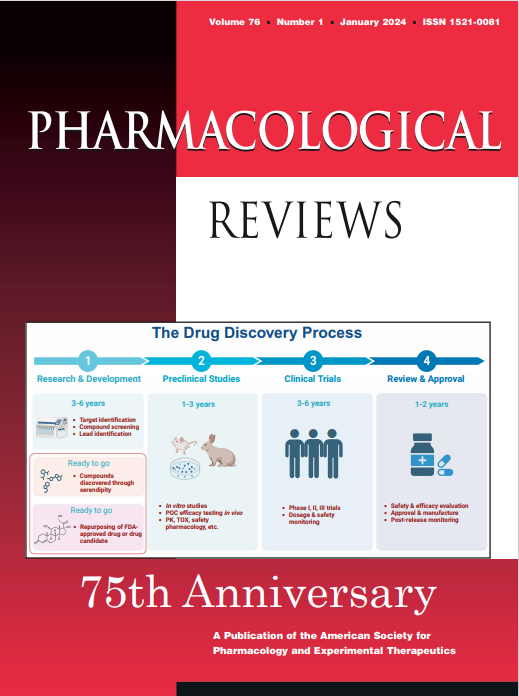Promising tools for future drug discovery and development in antiarrhythmic therapy.
IF 17.3
1区 医学
Q1 PHARMACOLOGY & PHARMACY
引用次数: 0
Abstract
Arrhythmia refers to irregularities in the rate and rhythm of the heart, with symptoms spanning from mild palpitations to life-threatening arrhythmias and sudden cardiac death (SCD). The complex molecular nature of arrhythmias complicates the selection of appropriate treatment. Current therapies involve the use of antiarrhythmic drugs (class I-IV) with limited efficacy and dangerous side effects and implantable pacemakers and cardioverter-defibrillators with hardware-related complications and inappropriate shocks. The number of novel antiarrhythmic drug in the development pipeline has decreased substantially during the last decade and underscores uncertainties regarding future developments in this field. Consequently, arrhythmia treatment poses significant challenges, prompting the need for alternative approaches. Remarkably, innovative drug discovery and development technologies show promise in helping advance antiarrhythmic therapies. Here, we review unique characteristics and the transformative potential of emerging technologies that offer unprecedented opportunities for transitioning from traditional antiarrhythmics to next-generation therapies. We assess stem cell technology, emphasizing the utility of innovative cell profiling using multi-omics, high-throughput screening, and advanced computational modeling in developing treatments tailored precisely to individual genetic and physiological profiles. We offer insights into gene therapy, peptide and peptibody approaches for drug delivery. We finally discuss potential strengths and weaknesses of such techniques in reducing adverse effects and enhancing overall treatment outcomes, leading to more effective, specific, and safer therapies. Altogether, this comprehensive overview introduces innovative avenues for personalized rhythm therapy, with particular emphasis on drug discovery, aiming to advance the arrhythmia treatment landscape and the prevention of SCD. Significance Statement Arrhythmias and sudden cardiac death account for 15-20% of deaths worldwide. However, current antiarrhythmic therapies are ineffective and with dangerous side effects. Here, we review the field of arrhythmia treatment underscoring the slow progress in advancing the cardiac rhythm therapy pipeline and the uncertainties regarding evolution of this field. We provide information on how emerging technological and experimental tools can help accelerate progress and address the limitations of antiarrhythmic drug discovery.未来抗心律失常治疗药物发现和开发的有望工具。
心律失常是指心率和心律不齐,症状从轻微的心悸到危及生命的心律失常和心脏性猝死(SCD)。心律失常的分子性质复杂,使得选择适当的治疗方法变得复杂。目前的治疗方法包括使用抗心律失常药物(I-IV 类),但疗效有限,副作用危险;植入式心脏起搏器和心律转复除颤器,但存在与硬件相关的并发症和不适当的电击。在过去十年中,研发管道中新型抗心律失常药物的数量大幅减少,凸显了该领域未来发展的不确定性。因此,心律失常的治疗面临着巨大的挑战,促使人们需要寻找替代方法。值得注意的是,创新药物发现和开发技术有望帮助推动抗心律失常疗法的发展。在此,我们回顾了新兴技术的独特性和变革潜力,这些技术为从传统抗心律失常疗法过渡到下一代疗法提供了前所未有的机遇。我们对干细胞技术进行了评估,强调了利用多组学、高通量筛选和先进的计算建模进行创新细胞剖析在开发精确针对个体遗传和生理特征的治疗方法方面的效用。我们深入探讨了基因疗法、多肽和多肽抗体给药方法。最后,我们将讨论这些技术在减少不良反应和提高整体治疗效果方面的潜在优势和不足,从而开发出更有效、更特异、更安全的疗法。总之,本综述介绍了个性化心律治疗的创新途径,特别强调了药物发现,旨在推动心律失常治疗的发展和 SCD 的预防。意义声明 心律失常和心脏性猝死占全球死亡人数的 15-20%。然而,目前的抗心律失常疗法疗效不佳且具有危险的副作用。在此,我们回顾了心律失常治疗领域,强调了心律治疗管道的缓慢进展以及该领域发展的不确定性。我们将介绍新兴技术和实验工具如何帮助加快进度并解决抗心律失常药物研发的局限性。
本文章由计算机程序翻译,如有差异,请以英文原文为准。
求助全文
约1分钟内获得全文
求助全文
来源期刊

Pharmacological Reviews
医学-药学
CiteScore
34.70
自引率
0.50%
发文量
40
期刊介绍:
Pharmacological Reviews is a highly popular and well-received journal that has a long and rich history of success. It was first published in 1949 and is currently published bimonthly online by the American Society for Pharmacology and Experimental Therapeutics. The journal is indexed or abstracted by various databases, including Biological Abstracts, BIOSIS Previews Database, Biosciences Information Service, Current Contents/Life Sciences, EMBASE/Excerpta Medica, Index Medicus, Index to Scientific Reviews, Medical Documentation Service, Reference Update, Research Alerts, Science Citation Index, and SciSearch. Pharmacological Reviews offers comprehensive reviews of new pharmacological fields and is able to stay up-to-date with published content. Overall, it is highly regarded by scholars.
 求助内容:
求助内容: 应助结果提醒方式:
应助结果提醒方式:


